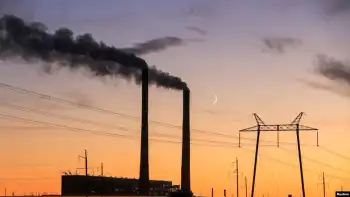Bridgeport coal plant denies “dirty” claims
BRIDGEPORT, CONNECTICUT - Vapors billowed out of the Bridgeport Harbor coal plant, providing a foggy backdrop for the Mini-Rite market just blocks away from it.
The clerk on duty, Christian Morel, thought the vapors were kind of pretty.
"It's just a part of Bridgeport, that's how I think about it," Morel said. "It's a part of us."
The coastal monolith has been in Bridgeport for 42 years, and is one of the largest coal plants in New England. It takes more than 140 people — and 230 tons of coal per hour — to keep the plant running. It has the ability to provide 387 megawatts of power, and along with the rest of the Bridgeport Harbor Power Station, provides power to nearly 530,000 homes when running at full capacity.
But to others, the plant is not a part of Bridgeport, but rather a health and environmental threat that needs to be removed. Environmental groups allege the plant fills the air with greenhouse gases that contribute to climate change and noxious gases that sicken those living nearby with heart attacks and asthma problems. Groups like Greenpeace, the Sierra Club and the Conservation Law Foundation are calling for the plant to be shut down by the end of the year.
The groups also claim the plant is an economic burden. As environmental regulations on the plant become increasingly strict and operation costs rise, running coal plants gets more expensive.
Since 2008, the plant's peak output in the summer has dropped 60 percent, but operating costs have gone up 30 percent during that same time, Greenpeace member Robert Gardner said. Those increased costs are eventually passed on to ratepayers, he said.
But Bridgeport Harbor will continue to run as long as there is a demand for its energy, Public Service Electric & Gas spokesman Nancy Tucker said. PSEG, a national energy company based in New Jersey, owns the power plant.
Yet Tucker did say that the plant has been running less often since the state started shifting to natural gas for the bulk of its power. ISO New England, the energy market that runs the entire New England grid, gets about 10 percent of its power from coal, according to its latest reports. Natural gas provides more than 42 percent of the power.
Coal plants around the country tend to be in low-income neighborhoods, said Jacqui Patterson, director of the climate justice department of the National Association for the Advancement of Colored People.
The PSEG plant is located in the West End, one of Bridgeport's poorest neighborhoods. The P.T. Barnum apartment complex is in the shadow of the power plant and some residents there said black coal dust can blanket the area in the summer months.
Employees of the plant contend the environmentalists are distorting the plant's impact.
"This is how I feed my family, so this job is important to me in that sense," said Kevin Cothran, an instrument and electrical specialist. "But at the same time, I live here and breathe the same air that everyone else does. So it's also important to me that the company does what it's supposed to do in meeting the requirements."
The Sierra Club alleges that because the plant has no scrubber an emissions filter it is releasing too many noxious gases into the air.
Plant officials say it doesn't need a scrubber. The plant uses coal from Indonesia that releases, at most, 0.1 percent sulfur dioxide, said Robert Silvestri, the plant's senior environmental engineer. As of 2010, state standards require no more than 0.3 percent emissions. Because the coal gives off such low emissions, the plant does not need a scrubber, he said. The plant used to use coal from Virginia and Kentucky that released 0.8 percent sulfur dioxide. PSEG switched to the Indonesian coal in 2002.
The cleaner coal emits drastically less waste ash as well, Silvestri said. And the ash it does emit is captured in what can be thought of as a giant vacuum cleaner bag and sold to cement companies. When it's added to cement, it makes it stronger.
The vapors that people see coming out of the plant are just steam, Silvestri said. The company says the Bridgeport power plant is among the 20 cleanest power plants in the nation.
Since switching coal sources and installing a $170 million mercury emissions control system, Tucker said the plant only released 951 tons of nitrous oxide, 1,273 tons of sulfur oxide, and 1.45 pounds of mercury in 2010. Save for some minor fluctuations, those numbers have been decreasing since 2002.
Still, pollution from the Bridgeport Harbor plant creates significant health problems — 15 asthma attacks, two heart attacks and one death per year, according to a Clean Air Task Force report. Those statistics don't include lung cancer and other respiratory issues, the report said.
Silvestri pointed out that on-road vehicles are responsible for 55 percent of the state's nitrous oxide emissions, while burning fossil fuels only accounts for 13 percent.
"But is it really politically correct to go after people in their automobiles?" Silvestri said. "I think the answer is no. But it's really easy to go after a power plant."
The Sierra Club also alleges the plant has an expired water permit and uses an antiquated system that discharges water as hot as 118 degrees, a dangerous temperature for some marine life.
Silvestri said the permit is not expired.
The Department of Environmental Protection is reviewing PSEG's application for a permit renewal generally required every five years, and the old permit is valid until the review is completed.
By law, the discharge water is not allowed to be above 106 degrees and no more than 26 degrees above the current water temperature, and the plant has been fully compliant, Silvestri said. The water could only reach the 106 degree limit if there are a series of extremely hot days in the summer, he said.
Only two plants in the region predate Bridgeport Harbor. One is the 85-year-old Somerset Power Generating Station in Somerset, Mass, which shut down last year because of changing supply and demand. The other is the 60-year-old Salem Harbor Power Station in Salem, Mass., which could shut down in 2014 because Dominion Energy, the company that owns it, announced it no longer wants to make the investments to keep it environmentally compliant.
A 20-year-old coal plant in Montville, the only other coal plant in Connecticut, filed for bankruptcy in February because of the increased cost of coal, transportation costs and environmental costs affecting ash disposal, according to court papers.
But Silvestri said he does not think the Bridgeport plant will shut down anytime soon.
"We've invested in the unit to make reliable electricity," Silvestri said. "I don't know what the other plants might have done."
Some environmentalists are calling for coal plants to be retrofitted for a different type of energy generation. They argue the infrastructure is already there and the plant is already connected to the energy grid.
When the Somerset plant announced it was closing, it also announced plans to repurpose the plant into one that would turn coal into synthetic gas. However, within the last month the company announced it was no longer pursuing those plans, partly because of a Massachusetts moratorium on using biomass to generate power.
Another option is to convert the plant into a natural gas plant. But energy consultant Joel Gordes, who is based in West Hartford, said that is not a good option, either. Natural gas is just another finite resource, he said, and in another 50 years, the state could be scrambling for another power source again.
PSEG did convert one of its coal plants in New Jersey into a natural gas plant, PSEG spokesman Nancy Tucker said. But the plant is very inefficient. The plant is only used on the hottest days of summer, Tucker said, and is slated to shut down completely in 2012. PSEG has no current plans to convert the Bridgeport Harbor plant to natural gas.
Environmentalists say there would still be plenty of energy available if the Bridgeport plant shut down.
If the Bridgeport plant were to cease operations, there would be no energy crisis, Gordes said. In fact, there wouldn't be much of an impact at all. Silvestri agreed that may be the case in May, but not in the coldest winter and hottest summer months.
It's not a good idea to close the plant, say many experts. Energy should be coming from many sources, they say.
An energy portfolio should be like a stock portfolio — diverse, said attorney Lee Hoffman, who served on Gov. Dannel P. Malloy's energy policy working group.
That New England is loading up more eggs in the natural gas basket, but keeping a couple of them in the coal basket too is good for energy security, Silvestri said.
"There are a lot of misconceptions of what goes on here and what the impact is from environmental perspective," Cothran, the plant electrical specialist, said. "People who work here recognize they do critical and important work."
Related News

New Program Set to Fight for 'Electricity Future That Works for People and the Planet'
LONDON - The Center for Biological Diversity on Monday rolled out a new program to push back against the nation's community- and wildlife-harming energy system that the climate advocacy group says is based on fossil fuels and a "centralized monopoly on power."
The goal of the new effort, the Energy Justice Program, is to help forge a path towards a just and renewables-based energy future.
"Our broken energy system threatens our climate and our future," said Jean Su, the Energy Justice Program's new director, in a statement. "Utilities were given monopolies to ensure public access to electricity, but these dinosaur corporations are…




